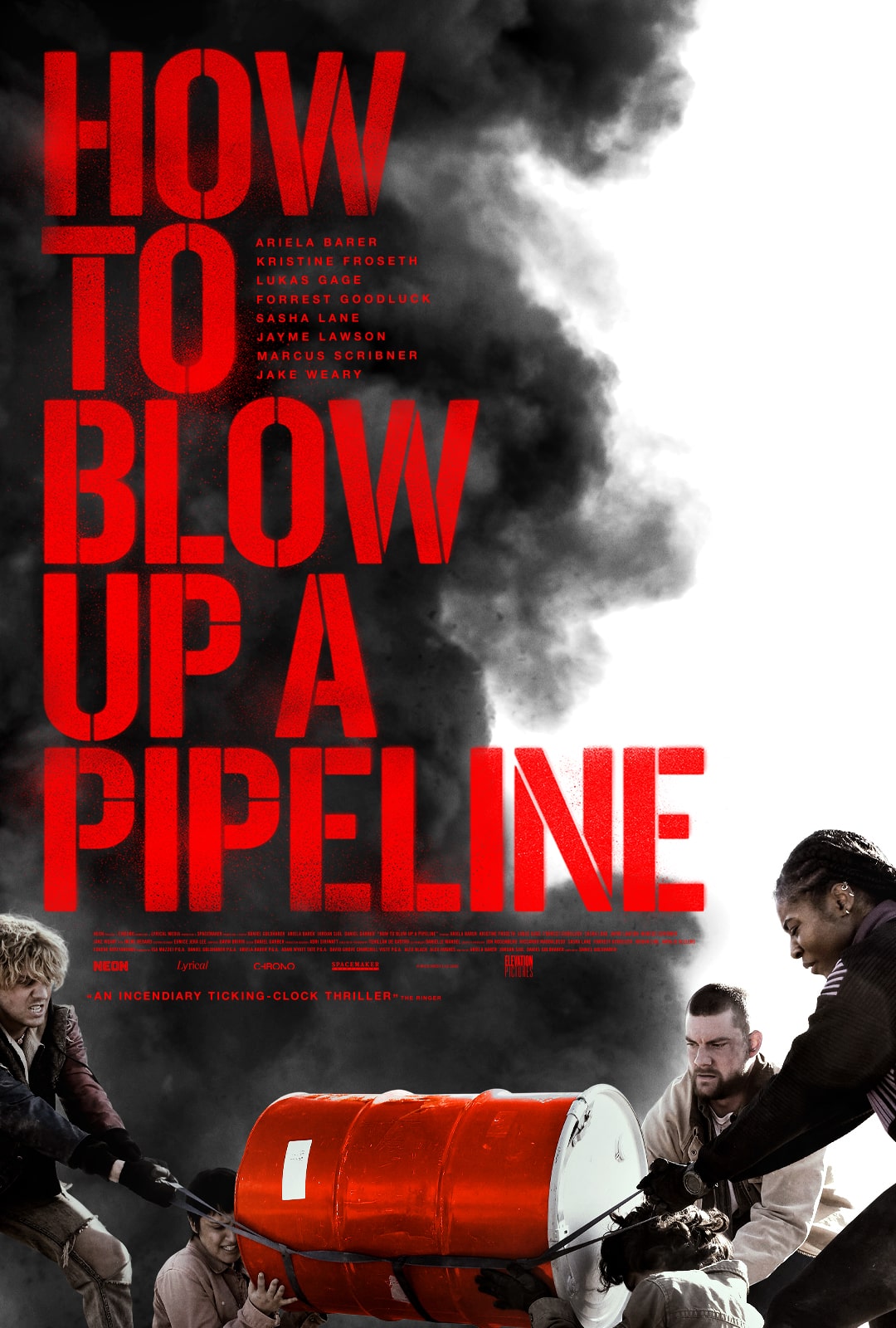
- Starring
- Ariela Barer, Kristine Froseth, Lukas Gage
- Writers
- Ariela Barer, Jordan Sjol, Daniel Goldhaber
- Director
- Daniel Goldhaber
- Rating
- 14A (Canada), R (United States)
- Running Time
- 103 minutes
- Release Date
- April 14th, 2023
Overall Score
Rating Summary
Whilst watching How to Blow up a Pipeline, I thought of how the audience I was watching it with would feel about the messaging and overall tone of the movie. My screening was in Alberta, Canada, home of one of the largest oil industries in the world. The messaging of this film, focused on environmentalism, activism, passive activism, and the push and pull of doing what is right, was certainly not lost on me, and probably not on those in attendance. Though the film takes place in Texas, the home of yet more oil, the parallels of the overall ideas of the film was certainly not lost on those in the room. In the end, How to Blow up a Pipeline is a good film to start conversations about activism and where the line is drawn when fighting for what you believe in.
How to Blow up a Pipeline is loosely based on a non-fiction book of the same name that argues property destruction can be a valid tactic in environmental justice, criticizing the pacifism in activism that he sees. The film centers around a group of young adults who come together to, as the title implies, blow up a pipeline to send a message about climate change and its environmental effect. The crew consists of Xochitl (Ariela Barer who is also a producer and co-screenwriter), who’s mother died in a heatwave, her best friend Theo (Sasha Lane), who is now dying of Leukemia, and Theo’s girlfriend Alisha (Jayme Lawson), who is overall skeptical of the whole plan and only going because of Theo. There’s Michael (Forrest Goodluck), who harasses oil workers near his home and posts on social media about making bombs, Dwayne (Jake Weary), a military veteran who helps the crew find a oil pipeline to destroy, Shawn (Marcus Scribner), who Xochitl met in university (prior to dropping out), and a couple named Rowan (Froseth) and Logan (Gage). While they seem like an unlikely grouping of individuals, they are nevertheless united by their common goal of believing not enough is being done about the current state of climate politics.
How to Blow up a Pipeline is mostly a thriller and a heist movie. Whilst the film revolves around the plan to blow up a pipeline (as physical property damage would get the most attention as opposed to the passive activism some of them had previously been a part of), that is not the entire focus of the film. In fact, the very act takes up marginally little screen time compared to the planning and backstory of the characters. The way the film is structured is smart, going back and forth between the present and the past and exploring the reasons as to why each person is choosing to be on this heist. The flashbacks are smartly inserted and never feel as if they are taking away from the story, rather, adding crucial material that helps the audience understand the character and their stories better.
The best element of How to Blow Up a Pipeline is how it builds tension in its core scenes. Throughout the film, characters handle live bombs and other explosive material that would certainly kill all of them if handled incorrectly. Through its cinematography and use of music, the audience sits on the edge of their seats, wondering if the mission could go horribly wrong for everyone involved. The use of tension is also owed in part to the character work, the audience cares deeply for the characters and aside from wanting to see the mission succeed, genuinely care about the characters and want them all to survive through the end. Once the end of the mission arrives, audiences will know as it flashes back and forth between two differing points of view and builds the tension of whether or not the characters involved survived. Ultimately, audiences will want to see everyone make it out alive.
One of the drawbacks of large ensembles, such as the one in How to Blow up a Pipeline, is that some characters are going to get less spotlight than others or it limits how deep a film can dive into its characters’ backstories. Though never at any point did any character feel unnecessary, more of Xochitl and Theo’s background would have been interesting. However, none of the characters never get lost in the ensemble, making them feel as if they all play a vital role amongst a large diverse cast showing the range of the effect of climate change. Of the actors, Barer was the standout as her character feeling honest and realized. Most of the actors overall (Goodluck felt a little awkward and unnatural with his delivery, and even if it was intended to come off that way, it never felt convincing) were great, with a great duo out of Forseth and Gage, especially towards the end as the film delved into their backstories. The chemistry between all the characters was pristine and the way each played off their differing dynamics is one of the key elements to having the story work.
Overall, How to Blow up a Pipeline is a film meant to fuel discussion about climate change and climate activism and how the two intersect. While watching the film, audiences are sure to find themselves wondering how they feel, morally, about what the group is doing and whether or not they “agree” with them. It shows the complicated nature of activism where perhaps blowing up properties with home made bombs isn’t always the answer while sitting by and pertaining in passive activism sometimes doesn’t allow for change either. The film may not have all the answers, but it doesn’t need to. Rather, the discussions around environmentalism, activism, and climate change will thrust audiences to engage in important dialogues that they might otherwise may not have had.
still courtesy of Elevation Pictures
If you liked this, please read our other reviews here and don’t forget to follow us on Twitter or Instagram or like us on Facebook.

Discover more from
Subscribe to get the latest posts sent to your email.
